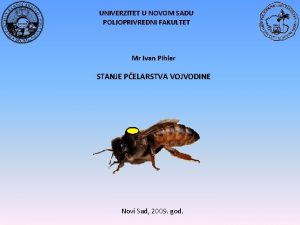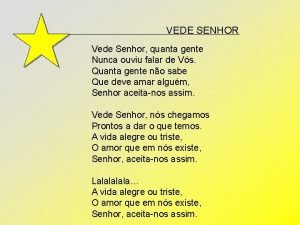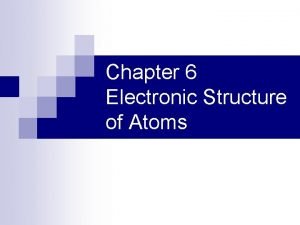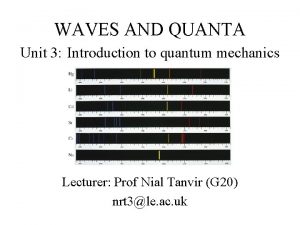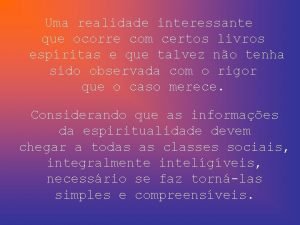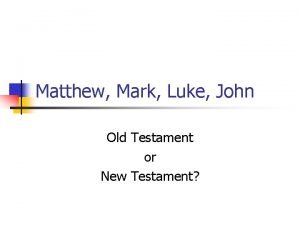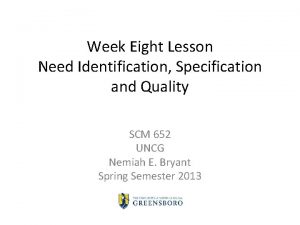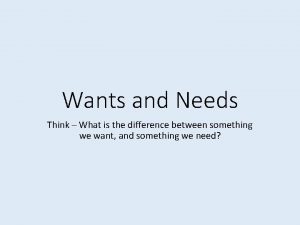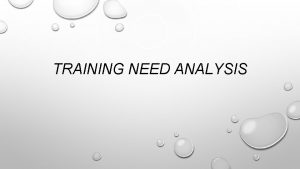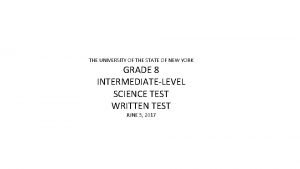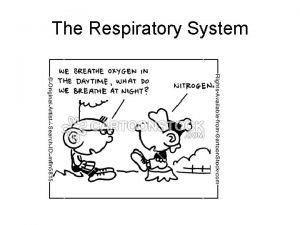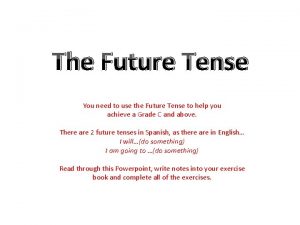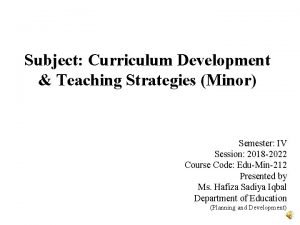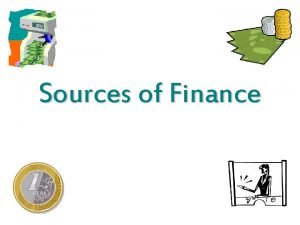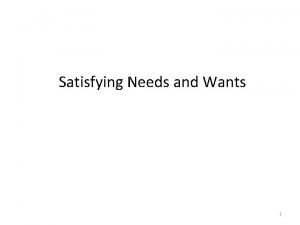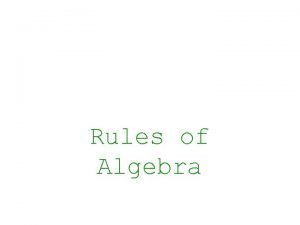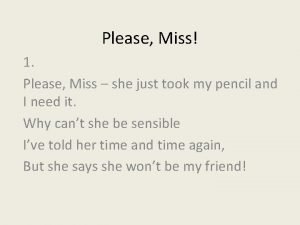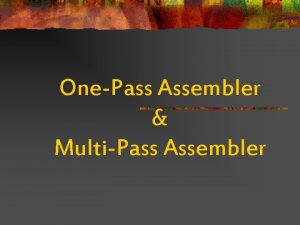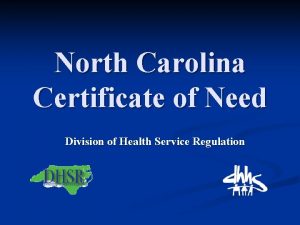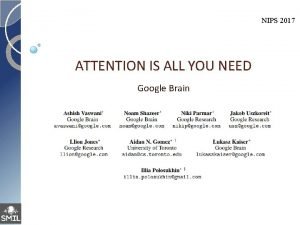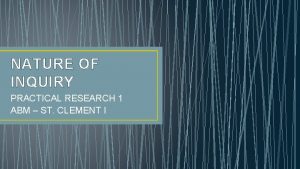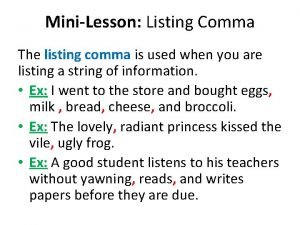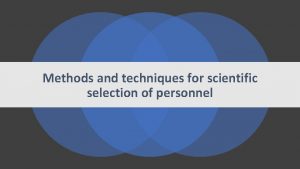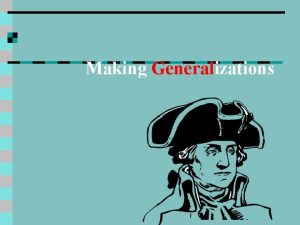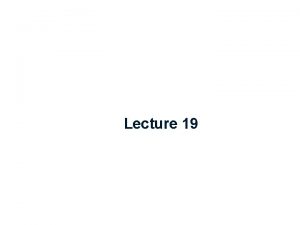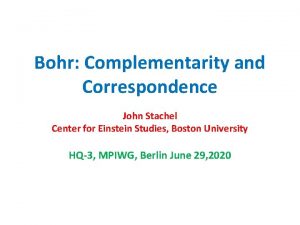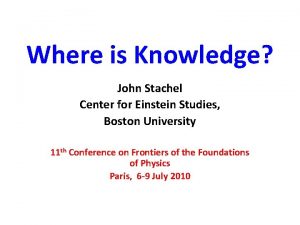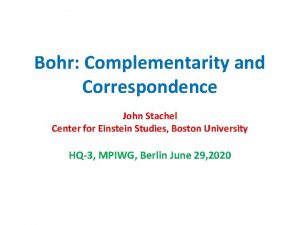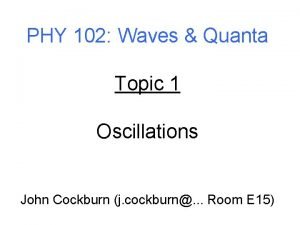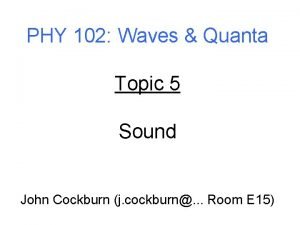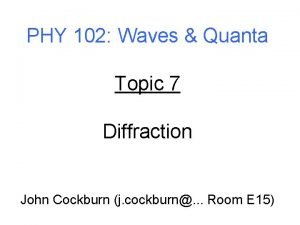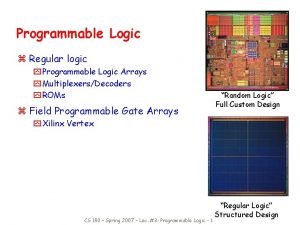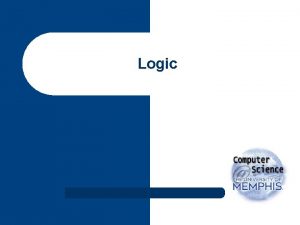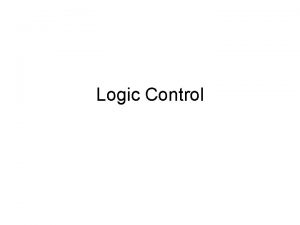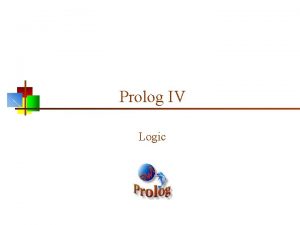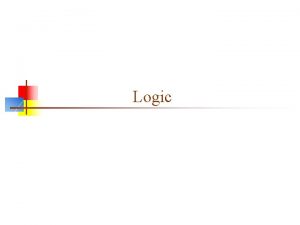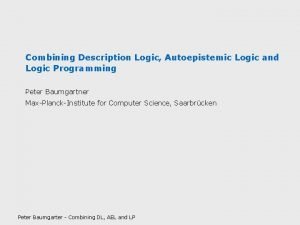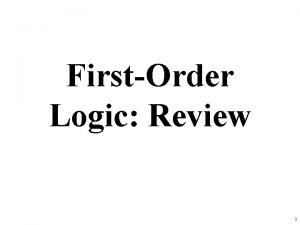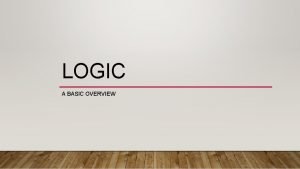Do Quanta Need a New Logic John Stachel

















![1) Conditional Properties With the definition of the logical 'negation' operator, [logic] has already 1) Conditional Properties With the definition of the logical 'negation' operator, [logic] has already](https://slidetodoc.com/presentation_image_h2/78b7e920d0ed76f96faf065cfac6898f/image-18.jpg)




























![Three Roads to Quantum Gravity “[R]elativity theory and quantum theory each. . . tell Three Roads to Quantum Gravity “[R]elativity theory and quantum theory each. . . tell](https://slidetodoc.com/presentation_image_h2/78b7e920d0ed76f96faf065cfac6898f/image-47.jpg)




































- Slides: 83

Do Quanta Need a New Logic? John Stachel Frontiers of Fundamental Physics 14 Epistemology and Philosophy Marseille, 17 July 2014

Do Quanta Need a New Logic?

Three Aspects of a Logic Syntax: A formalism, or set of symbols and rules for well-formed formulas using these symbols Semantics: An interpretation of the formalism: Its meaning as a description of some aspect of the world Pragmatics: Its application to that aspect of the world

Logic-Language-World Three steps: Logic is about Language, Language is about The World. Panlogism – The attempt to “short circuit” this process by identifying the real object and the “concrete-inthought” leads to the assertion: Logic is about The World

Aron Gurwitsch

Leibniz: Philosophie des Panlogismus “Things are realizations of concepts of reason. It is not sufficient to maintain that the logical and the ontological viewpoints can never be fully distinguished from each other, or that no separation, no abyss exists between reason and reality. One seems most faithful to the situation, if one speaks of an identity, or better of an equivalence of the logical and the ontological”

Panlogism Reborn! “ By panlogism I mean the philosophical tendency to obliterate the distinction between logical and ontological principles” JS, “Do Quanta Need a New Logic? ” (1986) I have been combating this viewpoint for over 35 years: ”The ‘Logic’ of Quantum Logic” in PSA 1974 (Dordrecht: Reidel 1976), pp. 515 -526.



Logic(s) For Quantum Mechanics If we abandon panlogism, and the search for The Logic of Quantum Mechanics, we shall see that quantum logics (note the plural!) are just different ways of reformulating the same content of quantum theory.

The Danger: If we accept one formulation of The Logic of Quantum Mechanics as providing the answers, it prevents us from confronting the real questions about the nature of quantum mechanics.

Chris Isham

Is it True; or is it False; or Some-where In Between? The Logic of Quantum Theory "A key feature of classical physics is that, at any given time, the system has a definite state, and this state determines-- and is uniquely determined by-- the values of all the physical quantities associated with the system. “ Realism is "the philosophical view that each physical quantity has a value for any given state of the system. “

In a Letter to Chris, I Raised Two Problems: 1) Conditional Properties: “each physical quantity has a value” 2) The Primacy of Process: “for any given state of the system”

First Problem: 1) Conditional Properties: “each physical quantity has a value” 2) The Primacy of Process: “for any given state of the system. ”

1) Conditional Properties This is just not true of conditional properties, as discussed in detail in Do Quanta Need a New Logic? The example I use concerns the properties "hardness h" and "viscosity v": Given a system defined by its chemical composition, the property "hardness" will only apply-- let alone have a numerical value on Moh's scale-- if the system is in its solid state; while "viscosity" will only apply if the system is in a fluid (liquid or gaseous) state.

Simple Classical Example Hardness and Viscosity can be applied to any substance, but not simultaneously. If it is in solid state, hardness applies; if it is in a fluid state viscosity applies.
![1 Conditional Properties With the definition of the logical negation operator logic has already 1) Conditional Properties With the definition of the logical 'negation' operator, [logic] has already](https://slidetodoc.com/presentation_image_h2/78b7e920d0ed76f96faf065cfac6898f/image-18.jpg)
1) Conditional Properties With the definition of the logical 'negation' operator, [logic] has already gotten as complicated as it gets. … [M]y article … discusses the difference between choice negation (-) and exclusion negation (∼ ) in general, and the inevitability of choice negation for a conditional predicate … if one wants to derive other predicates from it, and what follows from this choice even before getting to the special case of QM.

Non-Standard Logic Needed Semantics If we allow elementary propositions of the form: “System S has hardness h, ” “System S has viscosity v” Then a non-standard logic is needed: negation (“not”), conjunction (“and”) and disjunction (“or”) cannot all follow the laws of classical logic

Which Negation? How shall we interpret the proposition: “System S does not have hardness h 1” It could mean: “System S has some hardness h 2≠ h 1” or it could mean: “System S is not in the solid state, so the concept of hardness does not apply”

Which Negation? The law of the excluded middle: “p or not p is always true” (p∨∼p=I) If we choose “System S has some hardness h 2≠ h 1” Then the law of the excluded middle Is not valid for this variant of intuitionistic logic. To keep the law, we must choose the disjunction: “System S has some hardness h 2≠ h 1 or it is not in the solid state so the concept of hardness does not apply” This choice also leads to a non-standard logic!

Simplest Example Only Two States, Solid and Liquid: Solid State, only two values h 1, h 2 of hardness Liquid State, only two values v 1, v 2 of viscosity Then there are only four elementary propositions, symbolized by h 1, h 2, v 1, v 2 We also need symbols for: Negation (∼) The identically false proposition ϕ The dentically true proposition I

Simplest Example If we plot all possible combinations of propositions p, starting from the identically false proposition ϕ and ending with the identically true proposition I, and use dotted lines to represent logical implication, then we get the following diagram of a propositional lattice

Propositional Lattice. h 1 ( ∼h 2 ) . I (∼ϕ). . v 2 ( ∼ v 1 ) v 1 ( ∼ v 2 ). . ϕ (∼I ) . h 2 ( ∼h 1 ).

David Ritz Finkelstein

The Physics of Logic (1969) Finkelstein uses the same diagram to describe the polarization of photons, and states: “The system is the simplest quantum-like lattice and exhibits nondistributivity and coherence. ”

Enter Pragmatics But such propositions cannot be tested without the additional specification of the conditions C under which system S is being observed (e. g. , temperature T, pressure p). So if we add these conditions to the form of the proposition: “System S under conditions C has hardness h”

Classical Logic Returns! Then, either: The proposition is not well-formed, if system S is not in the solid state under conditions C, or: The proposition is well-formed, if system S is in the solid state under conditions C, and Classical logic holds for all well-formed propositions!

Objection Well and good for this example, but there is no analogue of the superposition principle in it. We cannot superpose two states S 1 and S 2 of different hardness or a state of hardness and a state of viscosity to get a new state S Answer: Let’s look at another classical example:


What Are Colors? Colors are literally in the mind of the beholder: The human eye and brain combine to interpret all electromagnetic waves within a certain range of frequencies that impinge on the retina in terms of three dimensions, e. g. : Brightness, hue and saturation or Three primary colors So colors are conditional properties of an open system, forming a 3 -dimensional vector space


Color Logic Three primary colors: Red Green Blue

Additive Color


They can be mixed (color superposition) to get: Magenta Yellow Cyan


Complementation Two colors are complementary if, when superposed (mixed) they produce white. Red Cyan Green Magenta Blue Yellow


Enter Logic Define elementary propositions: “Object O has color c” Interpret negation (“not”) as color complementation Interpret conjunction (“and”) as color addition And you have a non-standard logic with superposition of colors!

What Is a Quantum System? So neither conditional properties nor superposition are unique to quantum systems. Then what makes a quantum system? As we shall see, it is the role of h, the quantum of action.

What is Quantization? Quantization is just a way of accounting for the effects of h, the quantum of action, on any process involving some system, – or rather on theoretical models of such a system-- “fundamental” or “composite”, in which the collective behavior of a set of more fundamental entities is quantized

“Atoms and Human Knowledge” --Niels Bohr 1957 “. . an element of wholeness, so to speak, in the physical processes, a feature going far beyond the old doctrine of the restricted divisibility of matter. This element is called the universal quantum of action. It was discovered by Max Planck in the first year of this century and came to inaugurate a whole new epoch in physics and natural philosophy.

“Atoms and Human Knowledge” -- (cont’d) We came to understand that the ordinary laws of physics, i. e. , classical mechanics and electrodynamics, are idealizations that can only be applied in the analysis of phenomena in which the action involved at every stage is so large compared to the quantum that the latter can be completely disregarded.

The Second Problem 1) Conditional Properties: “each physical quantity has a value” 2) The Primacy of Process: “for any given state of the system”

Lee Smolin
![Three Roads to Quantum Gravity Relativity theory and quantum theory each tell Three Roads to Quantum Gravity “[R]elativity theory and quantum theory each. . . tell](https://slidetodoc.com/presentation_image_h2/78b7e920d0ed76f96faf065cfac6898f/image-47.jpg)
Three Roads to Quantum Gravity “[R]elativity theory and quantum theory each. . . tell us-- no, better, they scream at us-- that our world is a history of processes. Motion and change are primary. Nothing is, except in a very approximate and temporary sense. How something is, or what its state is, is an illusion.

Three Roads to Quantum Gravity It may be a useful illusion for some purposes, but if we want to think fundamentally we must not lose sight of the essential fact that 'is' is an illusion. So to speak the language of the new physics we must learn a vocabulary in which process is more important than, and prior to, stasis. ”

2) Primacy of Process Phrases such as "at any moment of time", "at any given time” may be applied in Newtonian-Galileian physics, which is based on a global absolute time. But from SR on to GR, this phrase involves a convention defining a global time. , and nothing physical can depend on the choice of convention!

2) Primacy of Process The only convention-invariant things are processes, each involving a space-time region. This suggests-- as do many other considerations-- that the fundamental entities in quantum theory are the transition amplitudes, and that states should be taken in the c. g. s. system (cum grano salis).

2) Primacy of Process And this is true of our measurements as well: any measurement involves a finite time interval and a finite 3 -dimensional spatial region. Sometimes, we can get away with neglecting this, and talking, for example in NR QM, about ideal instantaneous measurements.

2) Primacy of Process But sometimes we most definitely cannot, as Bohr and Rosenfeld demonstrated for E-M QFT, where the basic quantities defined by theory (and therefore measurable-- I am not an operationalist!) are space-time averages. Their critique of Heisenberg shows what happens if you forget this!

Closed versus Open Systems System Key Concept Closed Determinism Open Causality Determinism means fatalism: nothing can change what happens Causality means control: by manipulating the causes, one can change the outcome “Determinism is really an article of philosophical faith, not a scientific result” (JS 1968).

The Dogma of Closure When classical physics treated open systems, it was tacitly assumed (as an article of faith) that, by suitable enlargement of the system, it could always be included in closed system of a deterministic type. … The contrast between open and closed should not be taken as identical with the contrast between ‘phenomenological’ and ‘fundamental’ … (JS: “Comments on ‘Causality Requirements and the Theory of Relativity, ” 1968)

Do We Really Want Global? The systems we actually model are finite processes, and all finite processes are open. A finite process is a bounded region in spacetime: Its boundary is where new data (information) can be fed into the system and the resulting data can be extracted from it. Example: Asymptotically free in- and outstates in a scattering process.

Properties: Intrinsic and Extrinsic Intrinsic properties: Define the nature of the system Example: The mass, charge, and spin of an electron, proton, neutron, etc. Extrinsic properties: Depend on the relation of the system to its surroundings Example: The position, momentum, angular momentum of a system relative to some inertial frame of reference.

Heisenberg Physics and Philosophy Introduction by Paul Davies One is used to uncertainty in many physical processes – for example, in the stock market or in thermodynamics – but in these cases the uncertainty is due to missing information rather than to any fundamental limitation in what may be known about these systems.

Processes An open system can undergo a process: Preparation of the system, Interaction with its environment, Registration of some result.

Experiment vs Observation Experiment: The preparation result is fixed, predict the result of the registration (laboratory). Observation: The registration result is fixed, retrodict the result of preparation that led to it (astronomy, cosmology).

Classical System: Complete information allows us to predict/retrodiction with certainty. Incomplete information leads to compute the probability of a prediction/retrodiction.

What is Probability Ensemble interpretation: Large number of copies of the process. Probability is the ratio of number of copies giving the predicted outcome to the total number Propensity interpretation: Probability is the propensity of the process to give the predicted outcome

Quantum Logic (J. S. ) The conditional probability for a system initially prepared with position qi at time ti to be found in an interval dq around q at time t is given by: P(qi , ti; q, t) dq, where the probability density P(qi , ti; q, t) is proportional to the Van Vleck determinant of Hamilton’s principal function. This probability may be given a propensity interpretation for a virtual ensemble associated with a single system, or a frequency interpretation for an ensemble of identically prepared systems.

Heisenberg Physics and Philosophy Introduction by Paul Davies It is essential to appreciate that this uncertainty is inherent in nature and not merely the result of technological limitations in measurement. It is not that the experimenter is merely too clumsy to measure position and momentum simultaneously. The particle simply does not possess simultaneously precise values of these two attributes.

Bohr: Atomic Physics and Human Knowledge On the lines of objective description, it is indeed more appropriate to use the word phenomenon to refer only to observations obtained under circumstances whose description includes an account of the whole experimental arrangement. In such terminology, the observational problem in quantum physics is deprived of any special intricacy,

Atomic Physics and Human Knowledge and we are, moreover, directly reminded that every atomic phenomenon is closed in the sense that its observation is based on registrations obtained by means of suitable amplification devices with irreversible functioning such as, for example, permanent marks on a photographic plate, caused by the penetration of electrons into the emulsion.

What is a Quantum Process? A quantum process involves three stages: preparation, interaction, registration. Big question: How does h figure in the preparation and registration procedures?

Quantum System: The effects of the quantum of action h on the process cannot be neglected. In general, only probabilities 0 p 1 for such processes can be calculated (this does not exclude the occasional p = 0 or 1)

The Big Difference: If in some process, different interaction paths can lead from preparation to registration; then to get the total probability for that process, if the paths are: Distinguishable: add the probabilities for each path (classical) Indistinguishable: add the probability amplitudes for each path (quantum).

What is a Quantum-Mechanical Proposition? Much of the debate over quantum logic(s) hinges (implicitly if not explicitly) on the question of the quantum-mechanical analogue of the classical-mechanical propositions. Propositions about a classical system can refer to only the properties of the system itself, considered as closed-- that is, not interacting with anything outside the system.

What is a Quantum-Mechanical Proposition? But, as Bohr emphasized, the existence of the quantum of action h prevents such a complete separation between a quantum-mechanical system and its macroscopic surroundings. Quantum Mechanics can only deal with open systems. Two major consequences are:

What is a Quantum-Mechanical Proposition? (i) A full description of a quantum-mechanical phenomenon (see Bohr 1958) or process (see Feynman 1968– the word “process” will be used hereafter) must include a specification of the result of an initial preparation of the system, an account of the type of interactions it undergoes subsequently, and of the result of some act of registration (“measurement”) to which the system is finally subjected.

What is a Quantum-Mechanical Proposition? (ii) A maximal quantum-mechanical preparation or registration only specifies “half” the data about a system that would be specifiable classically. For example, while one could in principle prepare or register a classical-mechanical system with a determinate position and momentum, one can only prepare or register a quantummechanical system with either a determinate position or momentum.

What is a Quantum-Mechanical Proposition? A typical proposition about a process involving an electron might read: “At time t 1 the electron was prepared with momentum p 0, subsequently passed through a certain electric field E, and at a later time t 2 was registered at position q 0. ” Quantum mechanics assigns a probability to such a proposition.

Conditional Probabilities Note that, as in the classical case, all the quantum mechanical probabilities for a process are conditional; one does not ask for the probability of a final value b tout court, but its probability given an initial prepared value a. Once computed, these conditional probabilities obey the laws of the classical probability calculus based on classical logic.

Conditional Probabilities In contrast to the classical case, quantummechanical conditional probabilities cannot be attributed to ignorance but are fundamental. Without altering the physical conditions defining the process considered (thus producing a different process), it is impossible to further subdivide a quantummechanical ensemble into sub-ensembles– let alone into individual trajectories–

Conditional Probabilities for which probabilities (as opposed to probability amplitudes) can be defined. For example, a sample of undecayed radioactive nuclei all with the same average half-life cannot be subdivided it into sub-ensembles each with different predicted average lifetimes. (Of course, retroactively, after some or all have decayed, it is easy to do so. ).

What is a Quantum-Mechanical Proposition? Classical propositional logic is all that is needed to handle such propositions, describing a complete quantum-mechanical process. Logical problems begin when such propositions are truncated by omission of reference to the preparation and/or registration.

What is a Quantum-Mechanical Proposition? Attention is focused on “the state of the system at time t, ” to which one tries to attach a significance similar to that of the state in the classical case. The maximal goal of such an approach is to attribute a complete set of classical properties, e. g. , both position and momentum, to a quantum system in a given state.

What is a Quantum-Mechanical Proposition? These elementary propositions are then compounded by suitably-defined operations of conjunction (“and”) and disjunction (“or”) in an attempt to give meaning to the resulting compound propositions, even when the properties referred to in such compound propositions are incompatible quantum mechanically.

What is a Quantum-Mechanical Proposition? I shall not enter into further detail about the various possible non-standard logics that have been proposed for quantum mechanics (see my article Quantum Logic), but end with two reminders:

What is a Quantum-Mechanical Proposition? 1) If you accept panlogism (“The Logic of …”), this philosophical choice has nothing to do with quantum theory. 2) The choice of a logic (“Logics for … “) is just a matter of selecting one of various different ways to express the same content.

Final Word on Quantum Logic (Niels Bohr, 1939) The question of the logical forms which are best adapted to quantum theory is in fact a practical problem, concerned with the most convenient manner in which to express the new situation that arises in this domain.

 Roberto carlos quando eu quero falar com deus
Roberto carlos quando eu quero falar com deus Deus é deus slide
Deus é deus slide Banatska zuta matica
Banatska zuta matica Se cres em deus se acreditas que ele ha de voltar
Se cres em deus se acreditas que ele ha de voltar Quanta plastica finisce in mare ogni anno
Quanta plastica finisce in mare ogni anno Energy quanta
Energy quanta Electronic structure of atoms
Electronic structure of atoms Nial tanvir
Nial tanvir Quanta paz
Quanta paz Cameretta nome alterato
Cameretta nome alterato Quanta namera
Quanta namera First order logic vs propositional logic
First order logic vs propositional logic First order logic vs propositional logic
First order logic vs propositional logic Third order logic
Third order logic Combinational logic vs sequential logic
Combinational logic vs sequential logic Tw
Tw Software development wbs
Software development wbs Majority circuit
Majority circuit Combinational logic sequential logic 차이
Combinational logic sequential logic 차이 Logic chapter three
Logic chapter three This or that tag questions
This or that tag questions John old or new testament
John old or new testament John wants to buy a new computer
John wants to buy a new computer Split direct speech
Split direct speech New york, new jersey, pennsylvania, and delaware
New york, new jersey, pennsylvania, and delaware New oil and new wineskin
New oil and new wineskin Marquee cinema
Marquee cinema Articles of confederation characteristics
Articles of confederation characteristics New-old approach to creating new ventures
New-old approach to creating new ventures Marketing management kotler and keller
Marketing management kotler and keller Njbta
Njbta New classical and new keynesian macroeconomics
New classical and new keynesian macroeconomics Chapter 16 toward a new heaven and a new earth
Chapter 16 toward a new heaven and a new earth Neil thisse is a loyalist who fled the colonies
Neil thisse is a loyalist who fled the colonies New classical and new keynesian macroeconomics
New classical and new keynesian macroeconomics Roosevelt taft wilson comparison
Roosevelt taft wilson comparison You need a passport to cross the
You need a passport to cross the Why architects need to use their ears
Why architects need to use their ears Interests outside of school
Interests outside of school Uncg erm
Uncg erm Need of water purification
Need of water purification Difference between want and need
Difference between want and need Ic=beta ib+
Ic=beta ib+ Accountancy of lawyers
Accountancy of lawyers Whoa my love my darling
Whoa my love my darling Tna adalah
Tna adalah Eschooltoday
Eschooltoday You only need to be lucky once
You only need to be lucky once Shylock speech
Shylock speech What do the rabbit, fungus, and tree have in common? *
What do the rabbit, fungus, and tree have in common? * Why do we need to breathe
Why do we need to breathe Modal auxiliary passive voice
Modal auxiliary passive voice The future simple tense
The future simple tense Do we need sugar
Do we need sugar Apa standard reference
Apa standard reference Transition level of need tool
Transition level of need tool Importance of curriculum
Importance of curriculum Why do businesses need finance
Why do businesses need finance What are its objectives
What are its objectives Identify four skills that families need to stay healthy.
Identify four skills that families need to stay healthy. Satisfying needs part 6
Satisfying needs part 6 Child in need threshold
Child in need threshold Pre algebra formulas
Pre algebra formulas Central eight risk factors
Central eight risk factors Rights of basic needs
Rights of basic needs Miss she
Miss she Green plants make their own food by photosynthesis
Green plants make their own food by photosynthesis Chemical equation for cellular respiration
Chemical equation for cellular respiration Why we need computer
Why we need computer Define multi pass assembler
Define multi pass assembler Alj
Alj How do plants get nitrogen
How do plants get nitrogen Encoder and decoder applications
Encoder and decoder applications Present situation analysis
Present situation analysis Need for madness game
Need for madness game The detective needs more time to inquire about the case
The detective needs more time to inquire about the case Dare and need as modal verbs
Dare and need as modal verbs Why the oxford comma is important
Why the oxford comma is important Scientific selection
Scientific selection Contoh training need assessment
Contoh training need assessment Important of hrm
Important of hrm What is valid generalization
What is valid generalization Love is not all analysis
Love is not all analysis Assessing need for hrd
Assessing need for hrd


